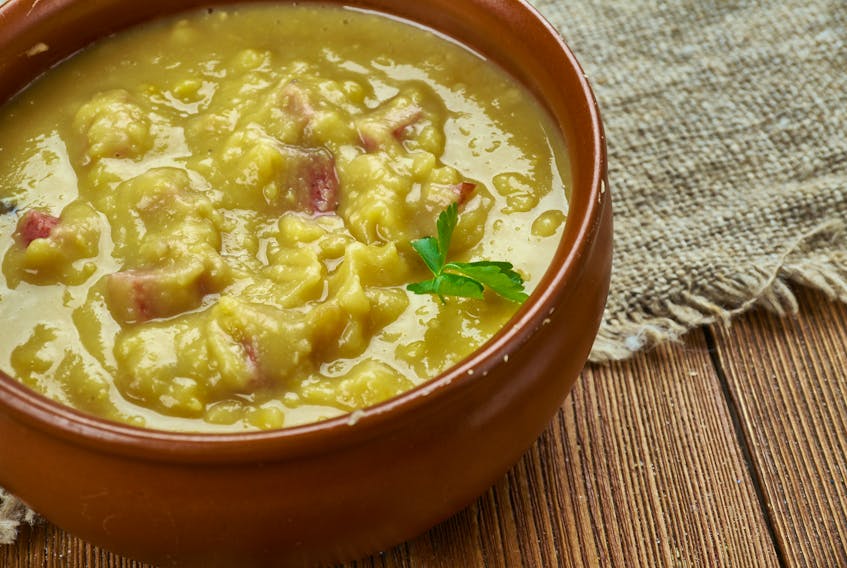Last week, I tried a number of recipes from the Belgian cookbook I received for Christmas, Mario Cattoor’s De Vlaamsche Pot” (Borgerhoff & Lamberigts, Ghent, 2006).
I found that many of the dishes utilize ingredients we’re familiar with in P.E.I., and made stoemp, a mixture of mashed potato and other vegetables similar to Dutch stampot, lamb stew, waffles and Flemish style cod. (To be accurate, I made Flemish style hake, because there was no cod available where I was shopping.
On Thursday, while the north wind whipped snow into our driveway and down the road, soup seemed like a good idea. I modified the recipe for pea soup that I found in the book and made a hearty soup that’s a meal by itself.
A meaty ham bone, the last bit of a bone-in ham, was the base for the stock used in this soup. Making stock with a ham bone is uncomplicated. Place the bone in a large saucepan, cover it in cold water, bring to a boil over high heat, and then adjust the heat and cover the pot so that the mixture will maintain a simmer, extracting the ham flavour from the bone.
After a few hours, strain the stock and remove the remaining ham from the bones, saving it to add to the finished soup.
Use either yellow or green split peas for the soup. I used green. Although I’ve never compared them, I have read that the flavour of yellow peas is a bit sweeter than that of green ones. For that reason, some cooks suggest omitting carrots when making soup with yellow peas. It depends on your personal taste.
Split peas are convenient because they do not have to be soaked overnight to begin rehydrating before cooking as dried beans or dried whole peas do. The recipe gives a range of cooking times for the peas because, depending on how long they have been stored and how dry they are, they can take more or less time to soften.
Bouquet garni, a recipe term, refers to a bundle of herbs tied together with kitchen string and used to flavour stocks, soups and stews. Since the dried bay leaves I use would crumble if I tried to tie them up with the other herbs, I added one to the soup along with the bouquet of thyme and parsley sprigs.
Another term in the recipe is “sweat”, as in “sweat vegetables until transparent.” It means to cook gently in oil, butter or other fat to draw out the juices of the vegetables so that they soften without browning. This is done over low heat, with the pan covered. Some sources say you should lay a piece of parchment paper or foil directly over the vegetables and then cover the pan.
The recipe calls for a leek, a milder-tasting member of the onion family. To prepare leeks, remove the green portion – can be used to flavour stock, and then discarded – and then halve the white part lengthwise. Rinse under running cold water, to wash out any grit trapped between the layers. Drain, and slice crosswise.
Pea Soup
- 300 g (300 mL/1.25 cups) split peas
- 1 leek
- 1 carrot
- 1 large onion
- 15 mL (1 tbsp) butter
- 1.5 L (6 cups) water, ham stock, chicken stock or vegetable stock
- Bouquet garni of thyme, bay leaves and parsley
- Salt and pepper to taste
Rinse the split peas in cold water. Place in saucepan, add the water or stock, bring to a boil, and cook for 60-90 minutes, until peas are soft and mushy.
Chop the leek, carrot and onion into small pieces. In a frying pan, melt butter and sweat vegetables over low heat until transparent.
Add vegetables and bouqet garni to the peas, and cook until vegetables are softened, about 30 minutes. Remove and discard bouquet garni.
Finish the soup by blending or putting it through a sieve, taste, and season to taste with salt and pepper. (I added a little slug of hot sauce too.)
If using ham stock, chop the ham that falls off the bones and add to the soup after puréeing. You can also add some crumbled bacon, blotted to remove excess fat, to the soup, or sprinkle it on top to garnish.
8 servings
Margaret Prouse, a home economist, can be reached by email at [email protected].









